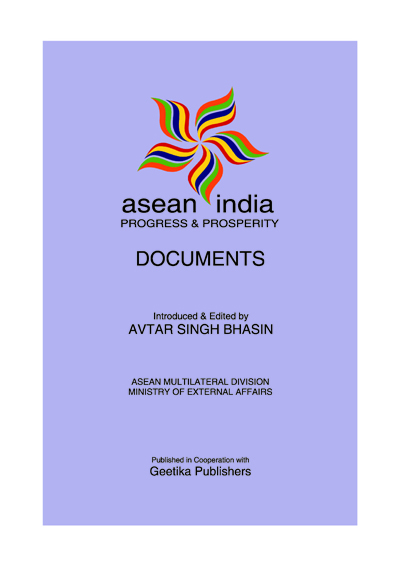
 |
 |
|||||||
|
 |
| |||
2. Prime Minister Dr. Manmohan Singh put the India-ASEAN
relationship in perspective when he said at the 9th India-ASEAN
Summit in Bali on November 19, 2011 that it "has benefitted
both of us and is contributing to the process of integration and
transformation of the Asia-Pacific region". At the 10th Summit
in Phnom Penh, he described the ASEAN as India's "bridge to
the East." The External Affairs Minister reinforced this
perspective at the Delhi Dialogue - IV on February 13, 2012
saying: "The ASEAN-India partnership is a natural one, founded
on congruent ideas and a common vision of the region and the
world, under-pinned by the strong civilizational linkages through
the millennia. We are convinced of the unique ability of our
partnership to further progress and prosperity, peace and
security in the region." The logo, the five-spoke wind turbine,
representing energy, motion, progress, connectivity and
dynamism, adopted for the Commemorative Summit, and
embossed on the cover of this book, further reinforces India's
commitment to the objectives of the ASEAN. 3. The book, which catalogues the documents bearing on India's interaction with the ASEAN during the last two decades, serves as a reminder that both India and the countries of the Association take "cognizance of the ground covered by the two in a relatively short span of time and the very varied and rich agenda of cooperation which is being seen by many, even asean india outside our countries, as a stable anchor for the process of integration and transformation in the Asia - Pacific region". 4. The documents have been arranged chronologically to showcase the progressive and wide-ranging development of relations and the vitality and vigour injected in doses to ensure that both the body and the mind stay healthy. In reproducing the documents, every effort has been made to adhere to the original text in terms of the punctuation and the spellings of the names of persons and places as occurring in the original. 5. In the rather lengthy introduction, I have highlighted the centrality of Asia in the foreign policy paradigm, since India's independence. It sought to revive the ancient civilizational, religious and linguistic links, unfortunately disrupted by the colonial domination of the region and of India as well. Sometimes, the notion of "Look East Policy" creates an erroneous impression that India's engagement with the countries of Southeast Asia began only at the start of the nineties of the last century, when this term came into vogue. The long narrative is intended to correct that flawed misperception. Asia and particularly Southeast Asia remained at the centre-stage of India's foreign policy formulations, since its independence. 6. While working on this book, I used the facilities of the Library of the India International Centre, and received the unstinted help from its Librarian Dr. Maujamdar and his colleagues, Shafali and Rajiv. I am grateful to them for their generous help and assistance. 7. I would like to thank Shri Sanjay Singh, Secretary (East) for his very positive response, when the idea of this book, for the Commemorative Summit, was first mentioned to him, and made it possible for the book to come out in time for the 20th India - ASEAN Commemorative Summit. I would also like to thank Shri Vasanth Kumar who provided the coordinating link with the Ministry. 8. I am particularly thankful to Ambassador Gurjit Singh for his ready offer of help in locating some of the documents bearing on the subject. 9. A number of friends responded to my request to go through the introduction and offer their comments. I am grateful to all of them for their valuable comments and suggestions, which made the narrative rich and purposeful. I would particularly like to mention the names of Ambassador S.T. Devare, Ambassador A.N. Ram, Ambassador Mrs. Suryakanthi Tripathi and High Commissioner TCA Raghavan. I, however hasten to add, that I remain fully responsible for the views expressed and for any other deficiency that may be found in the book. |
November 25, 2012 |
 |
|